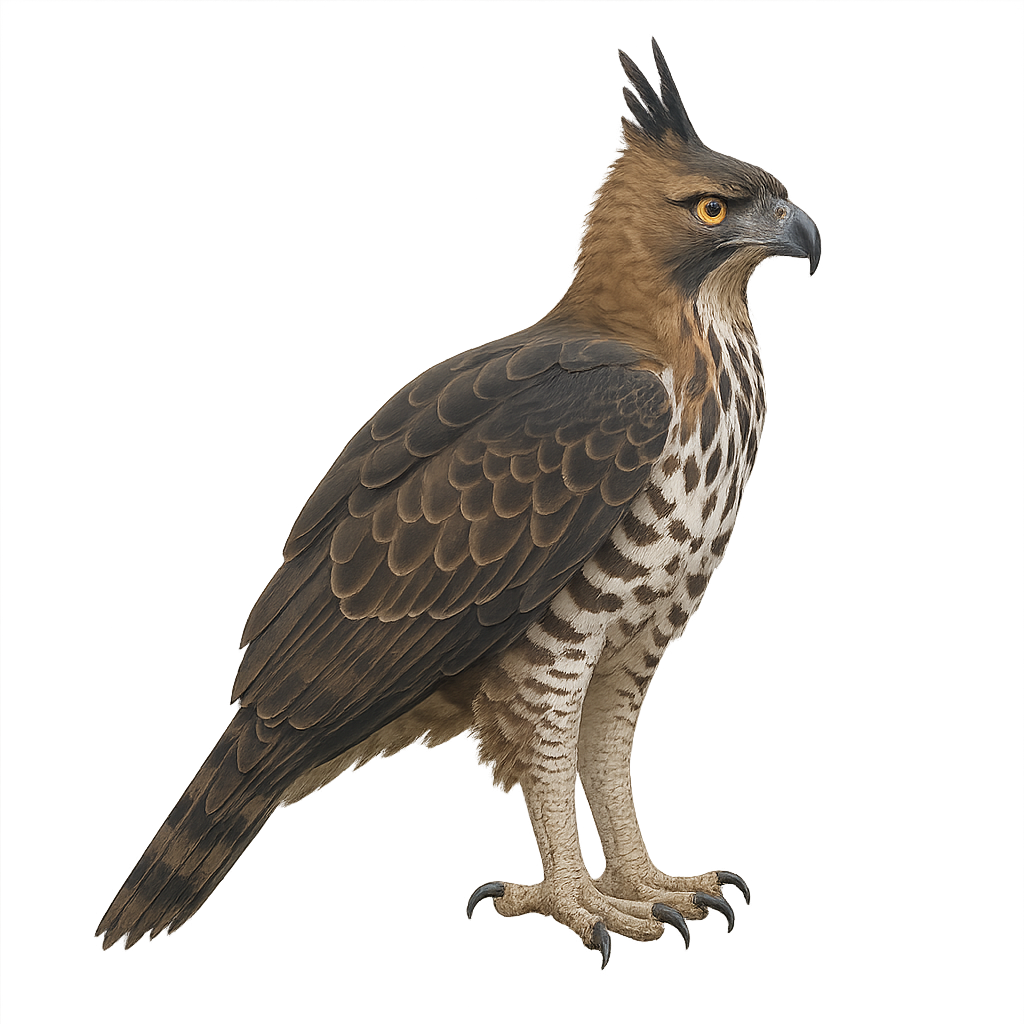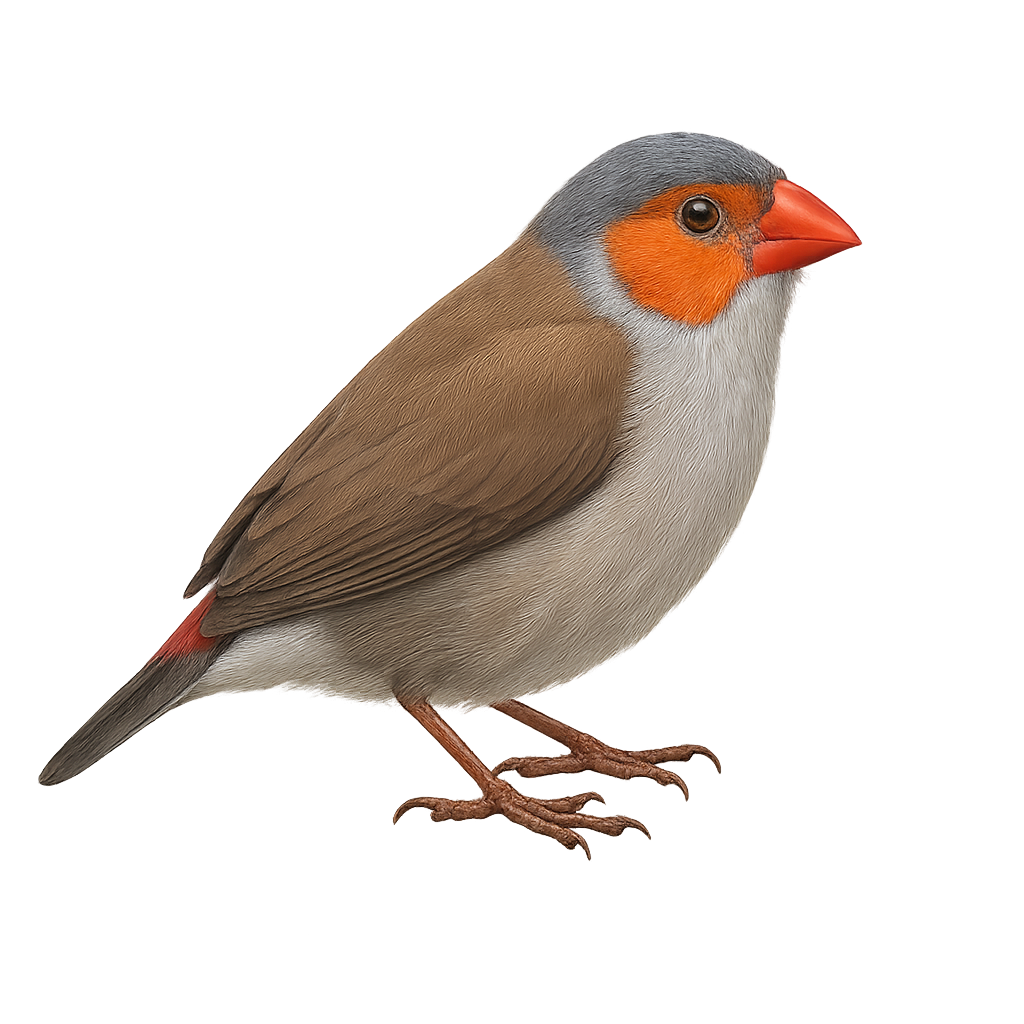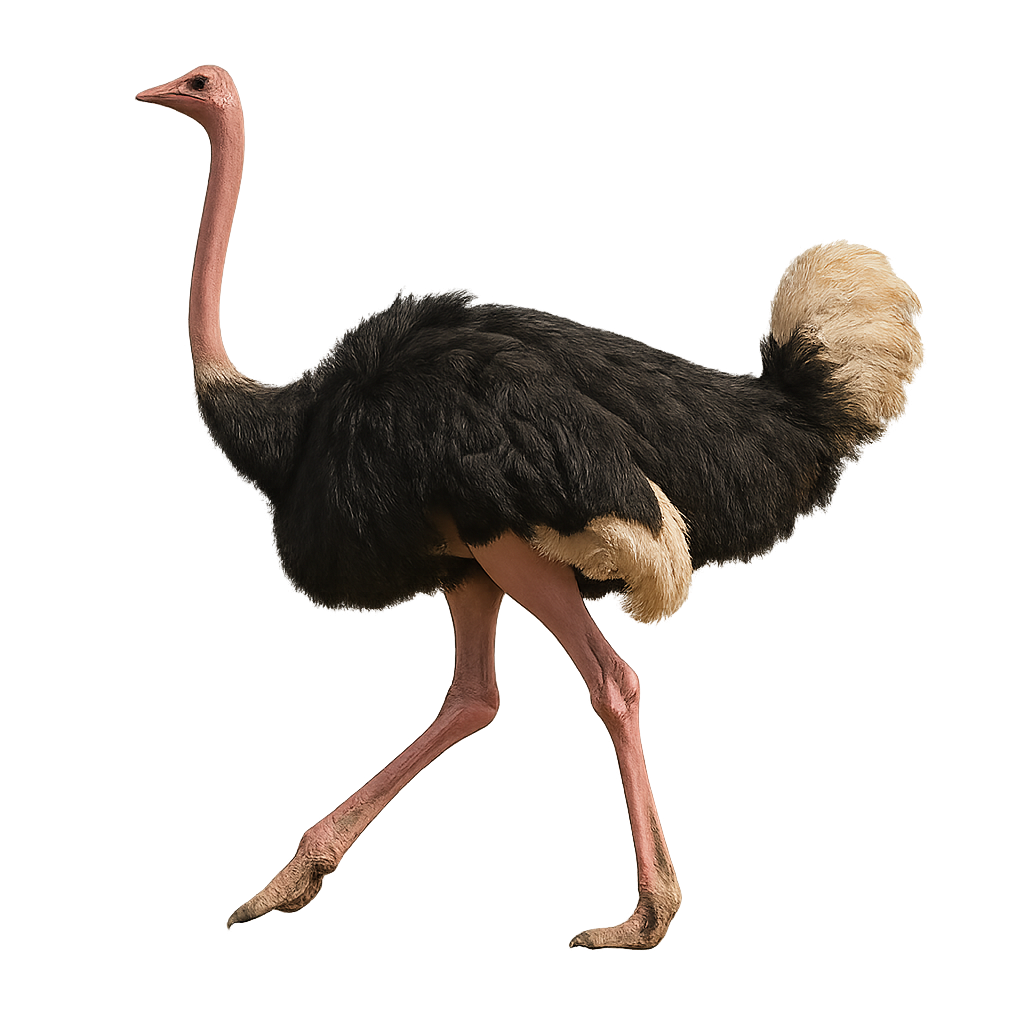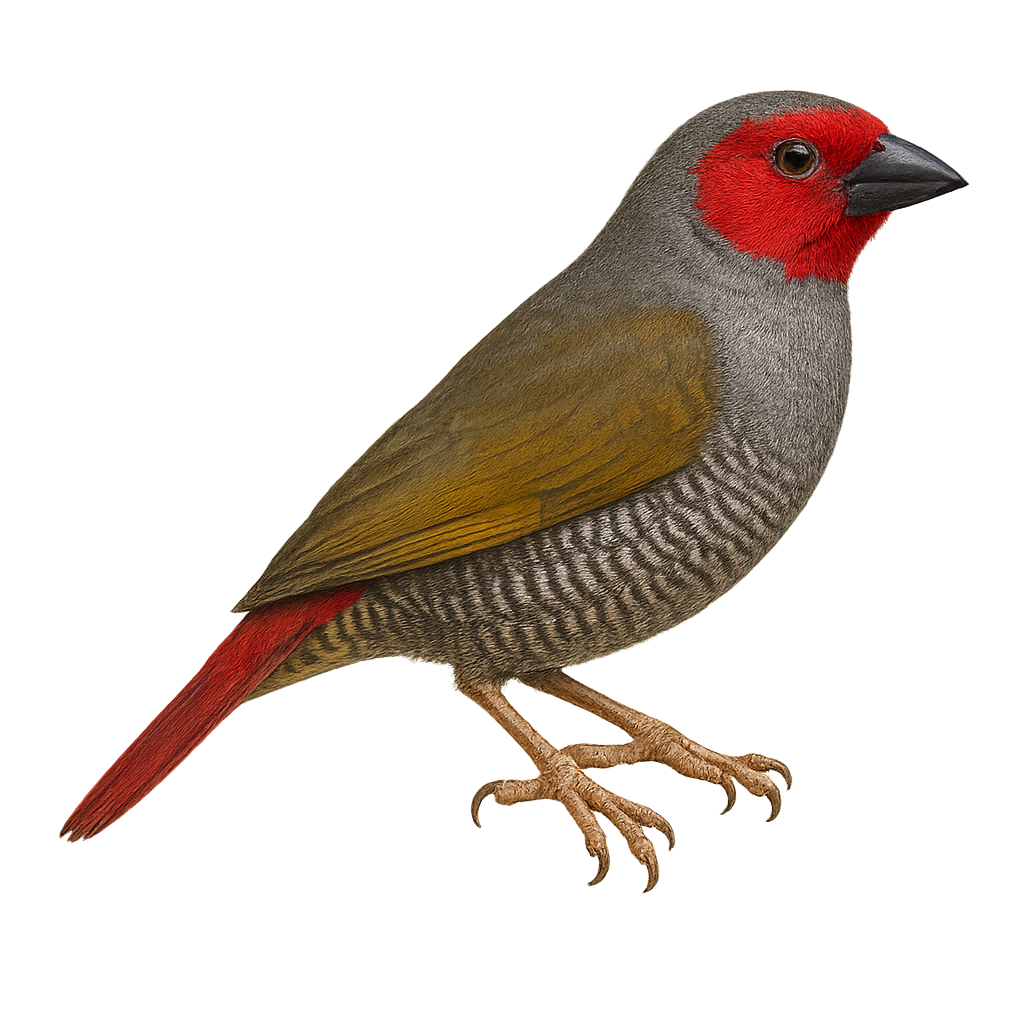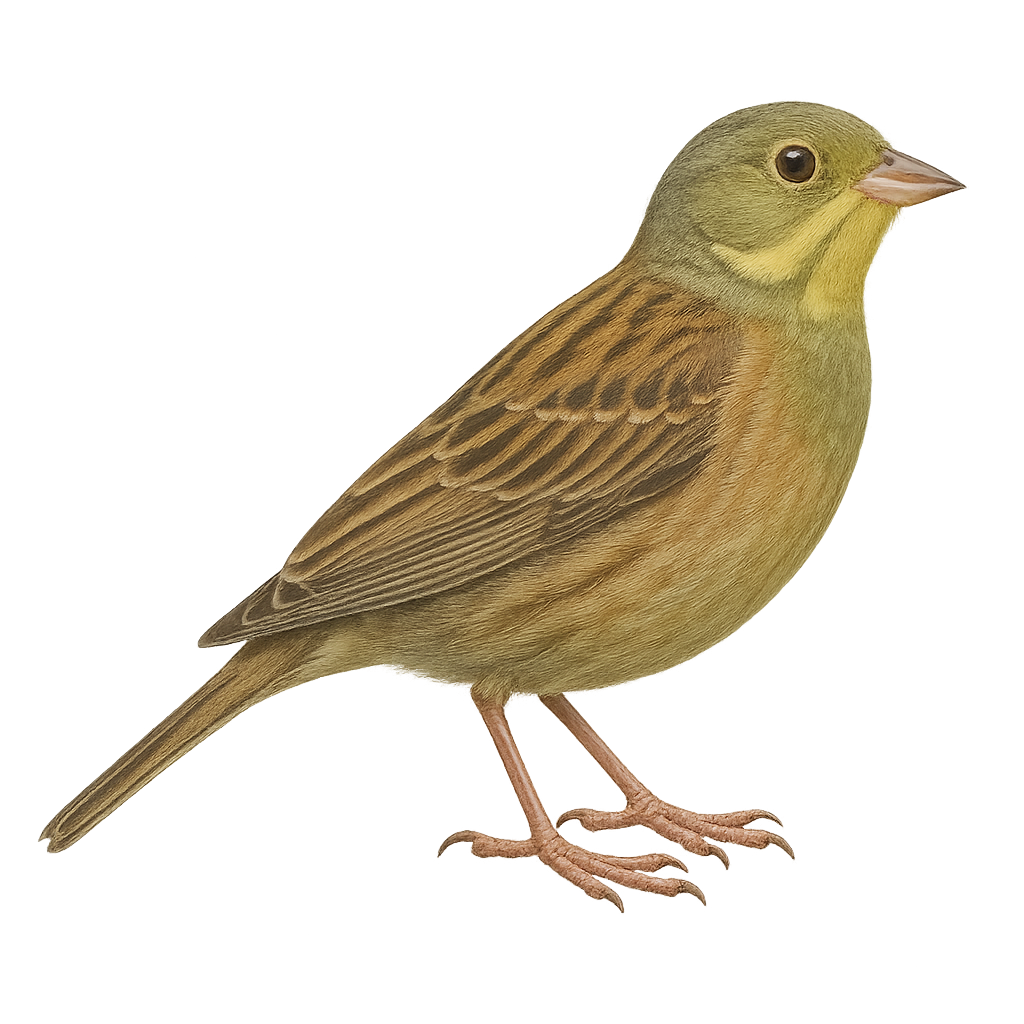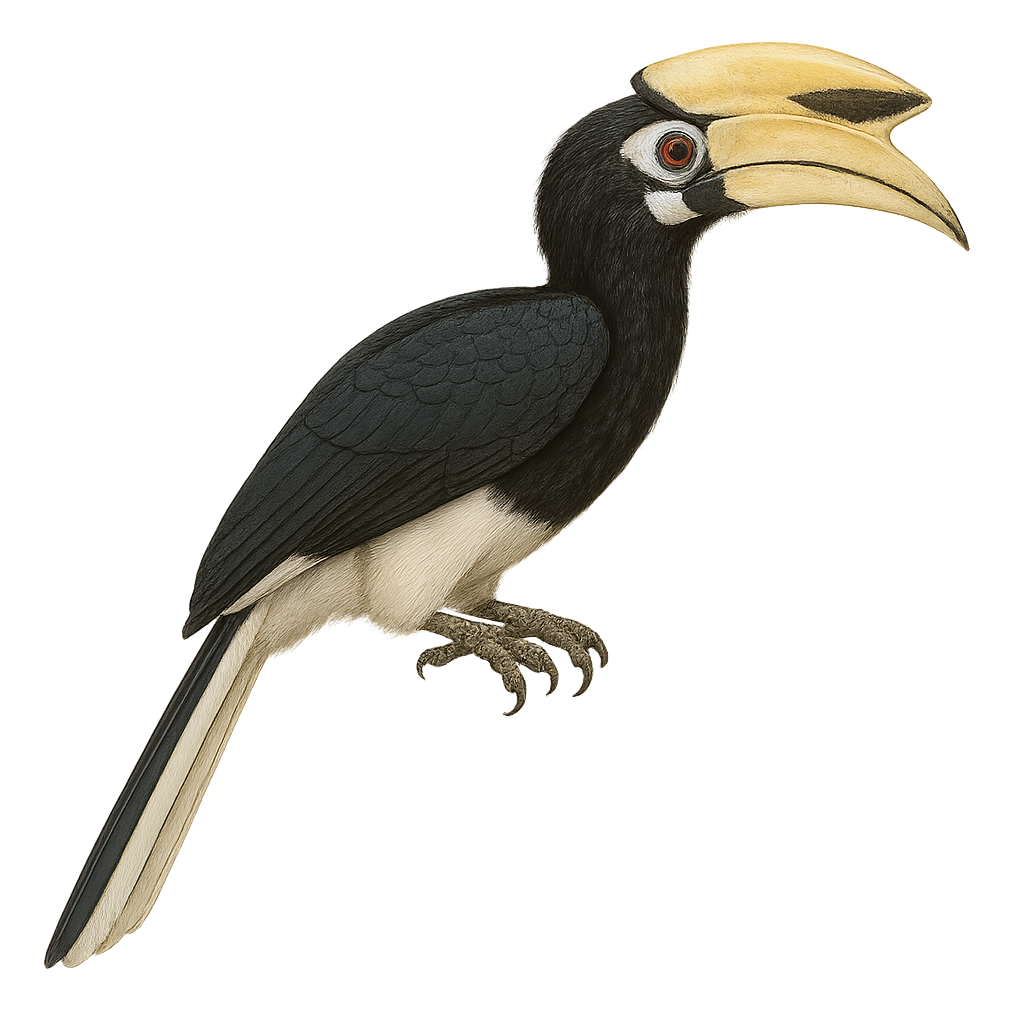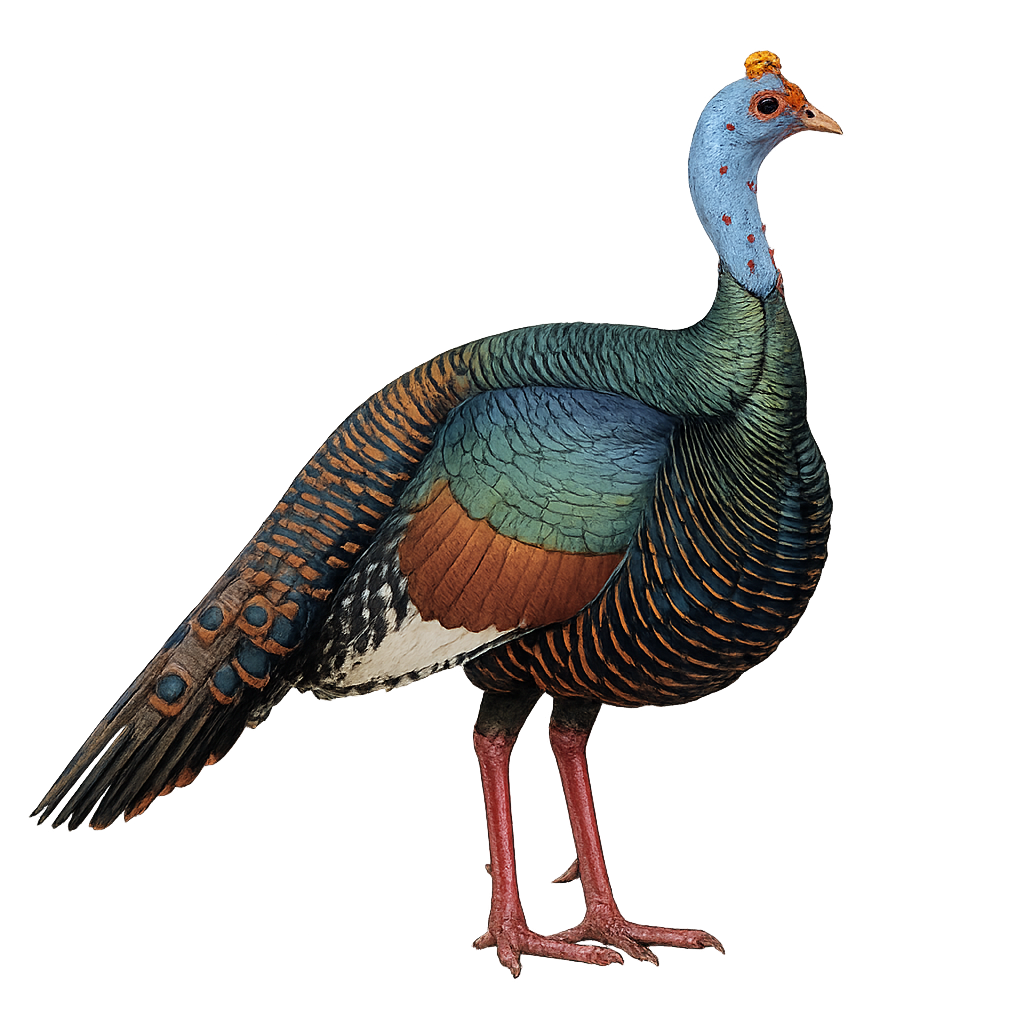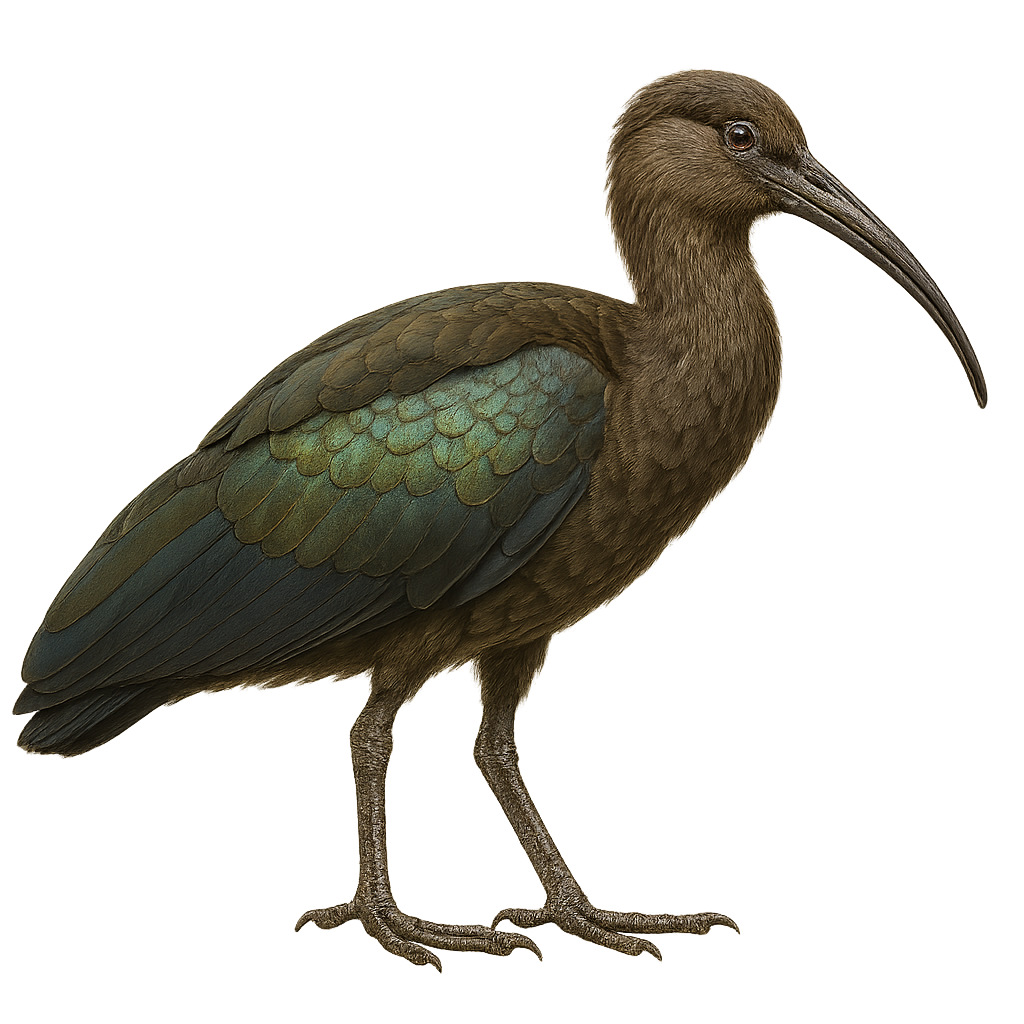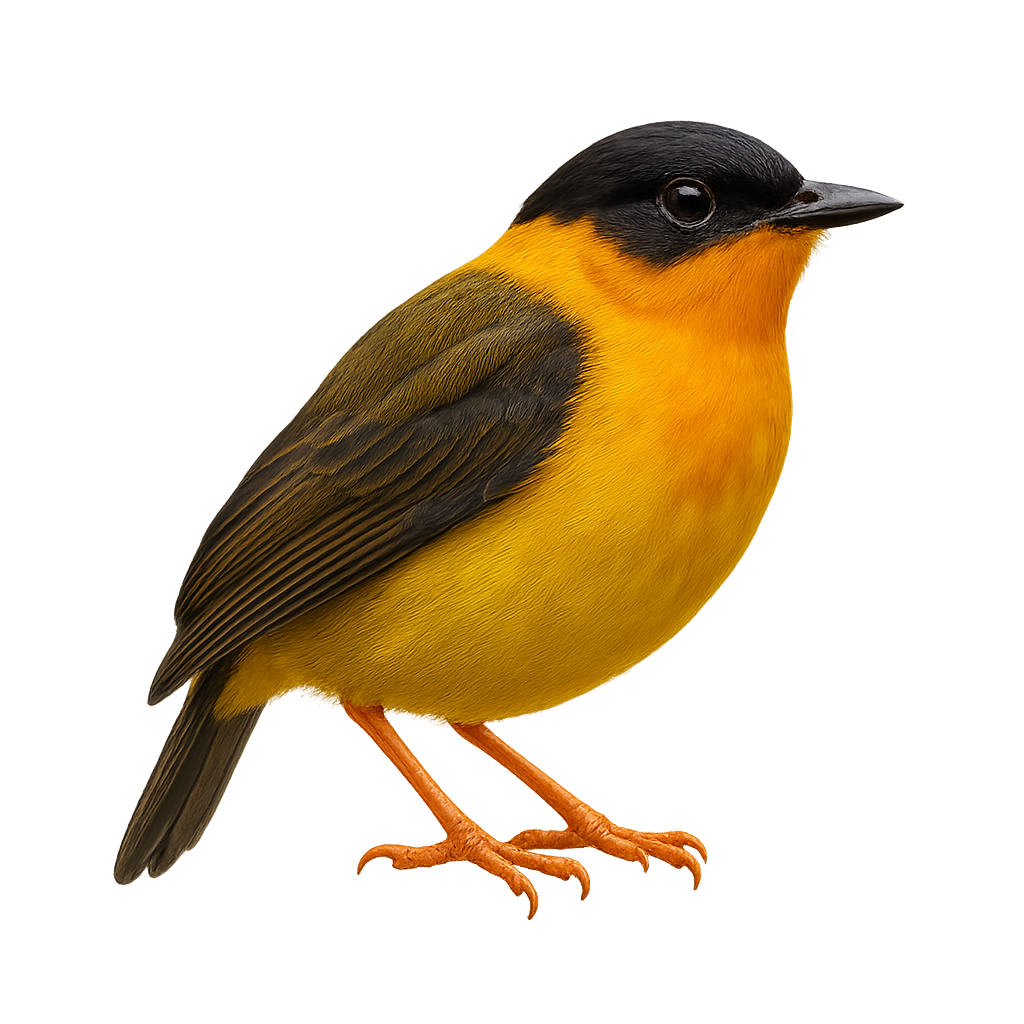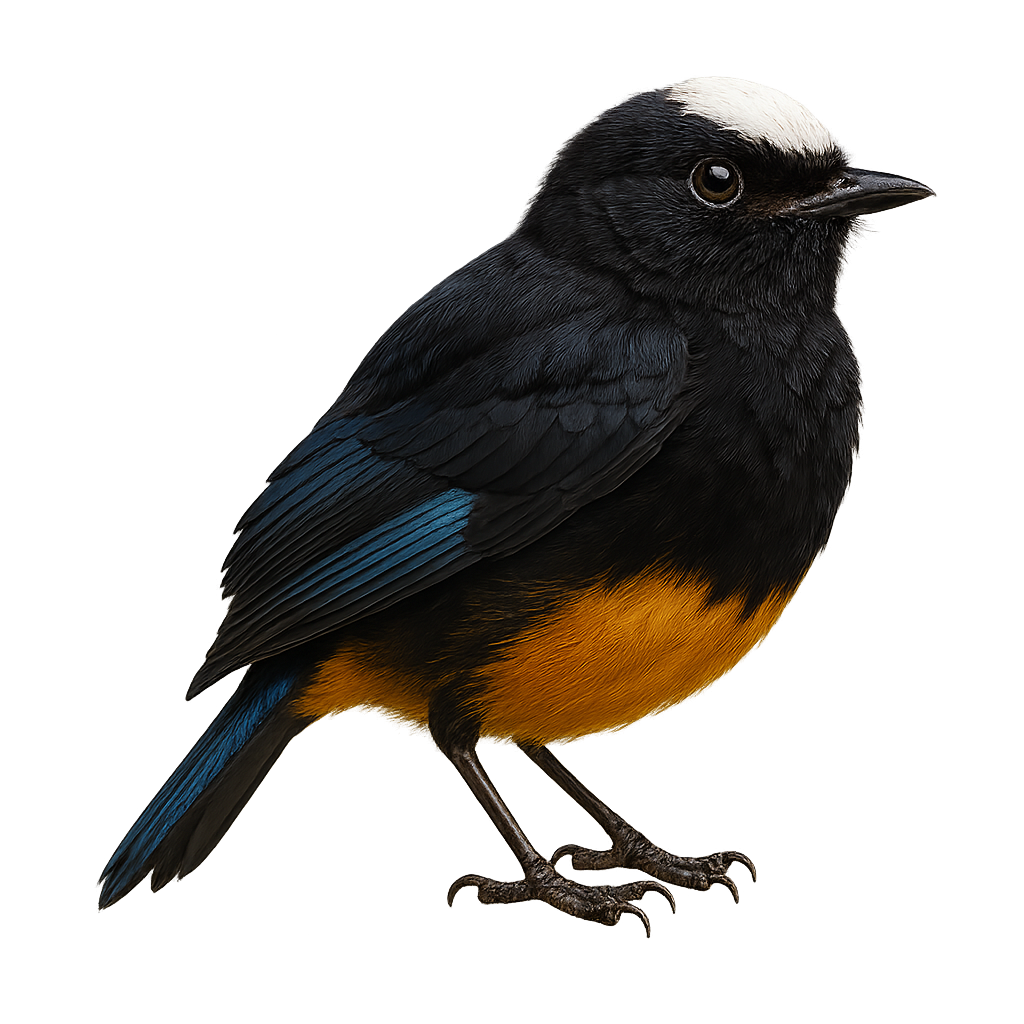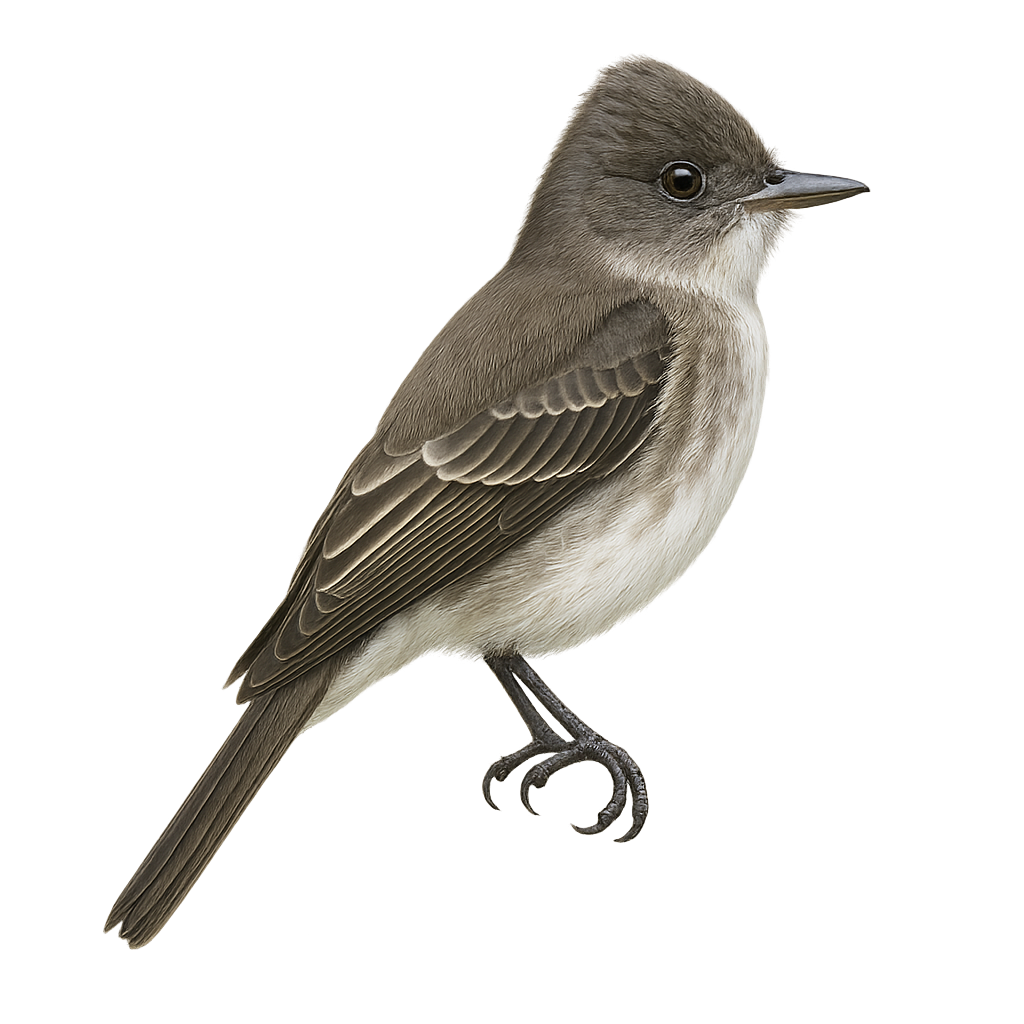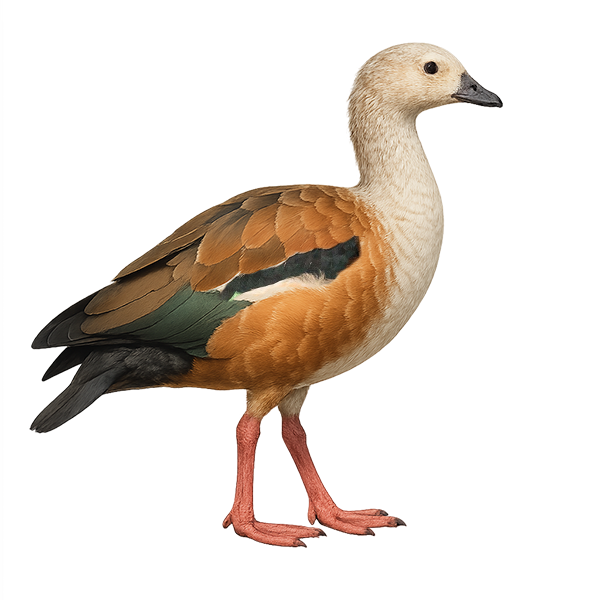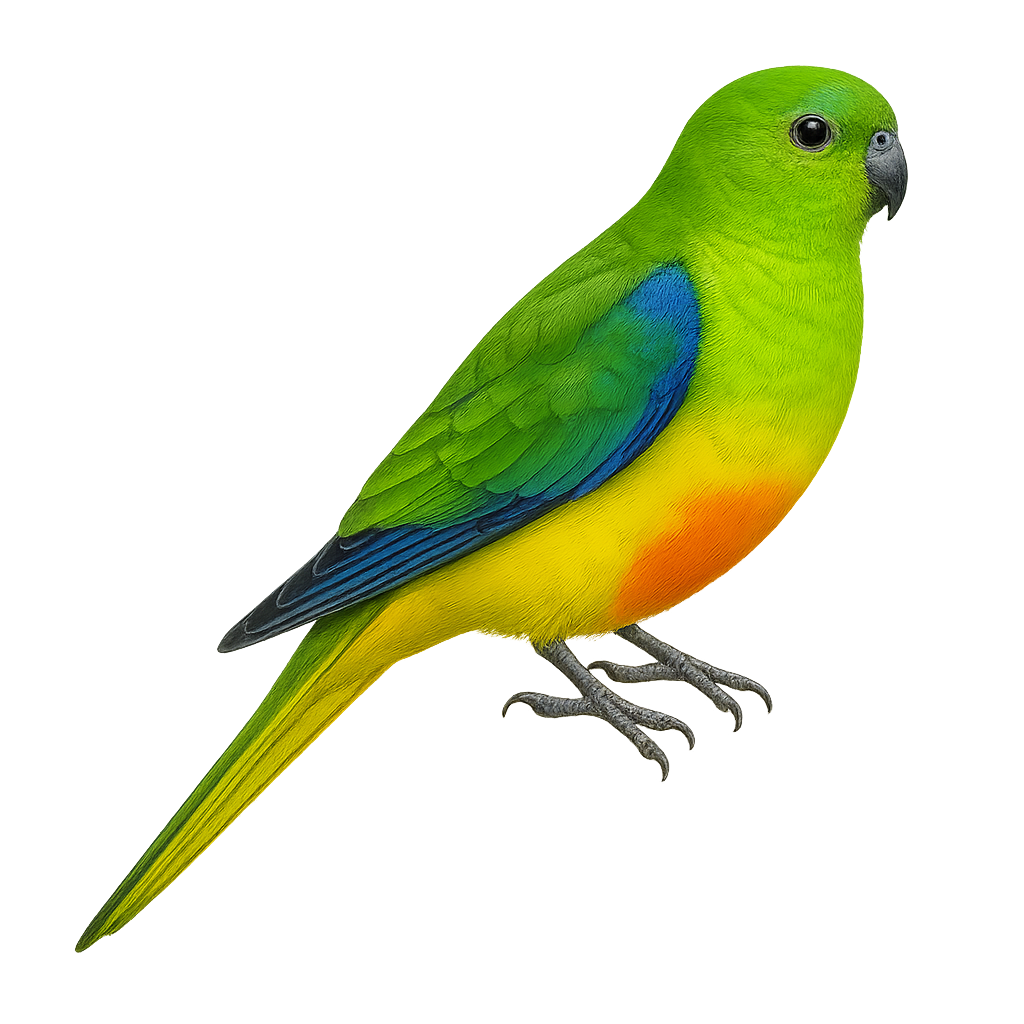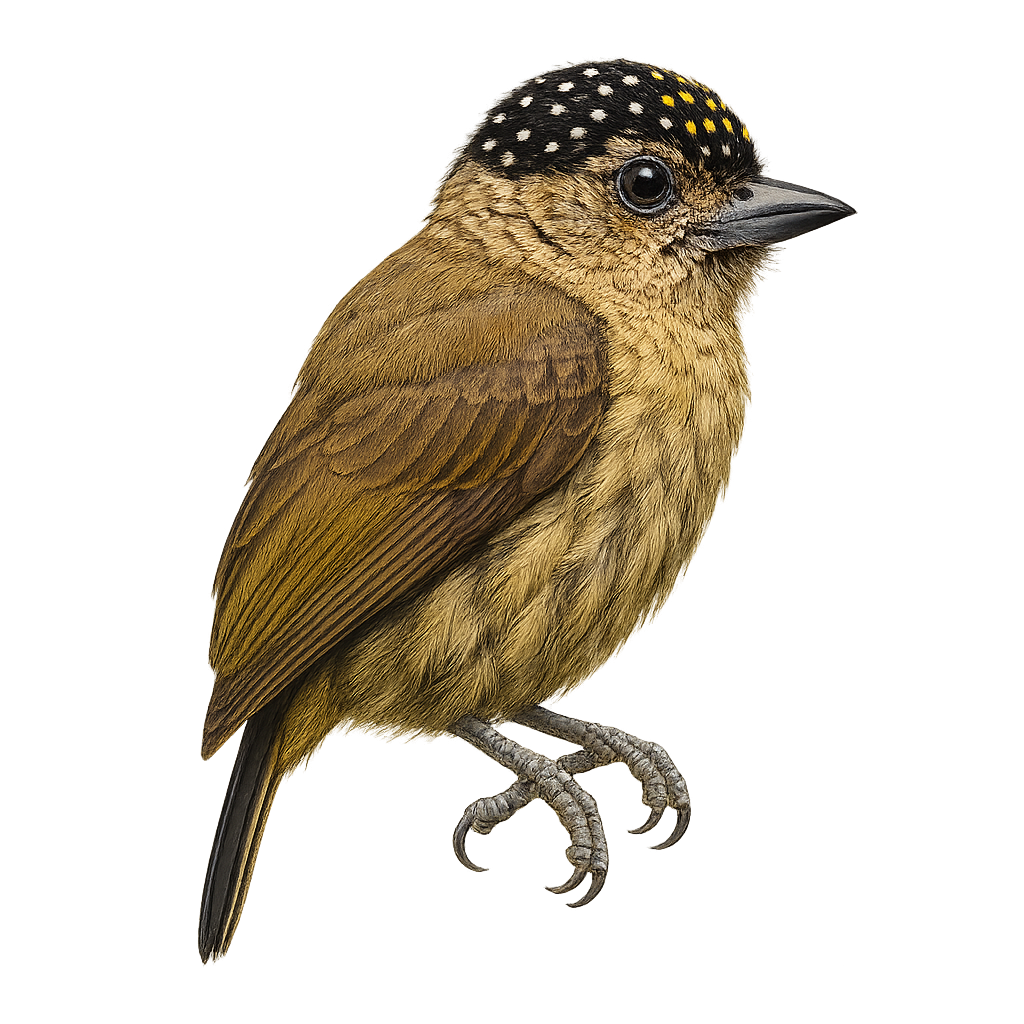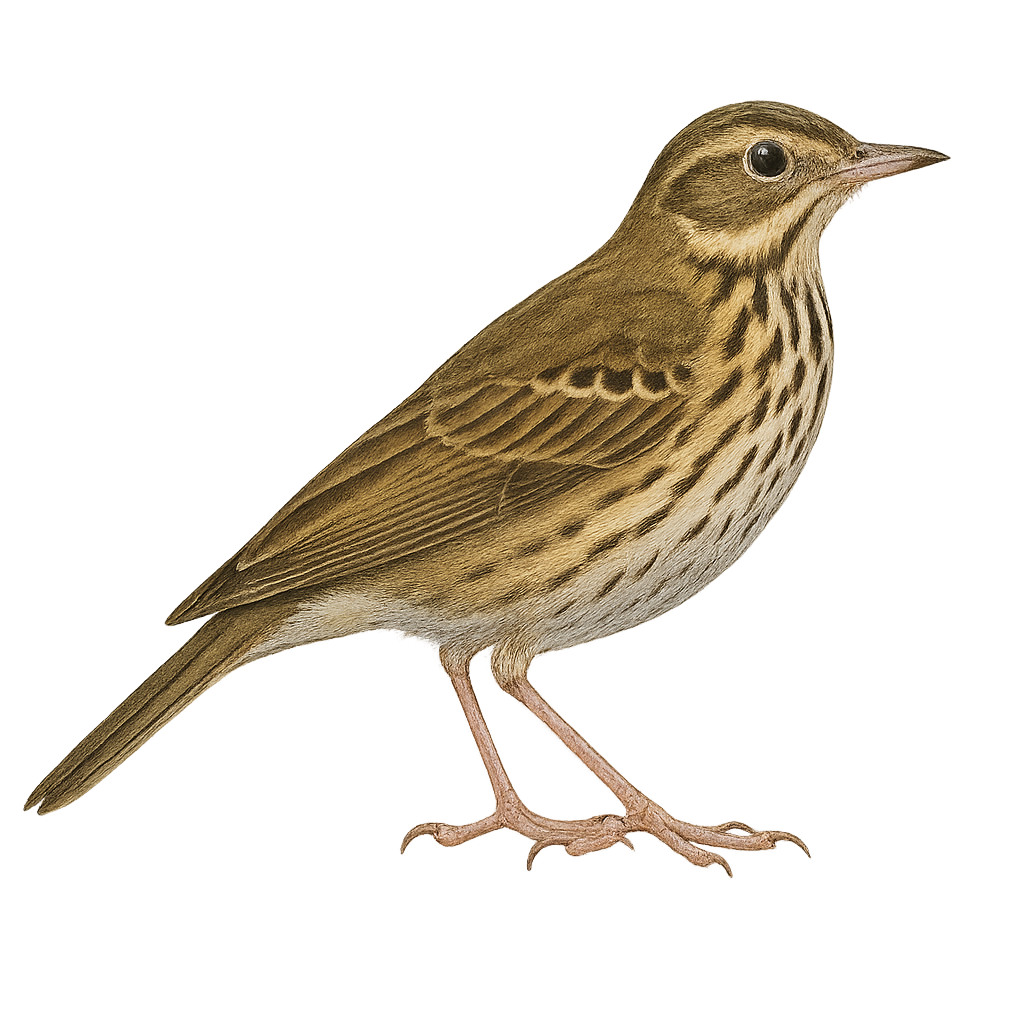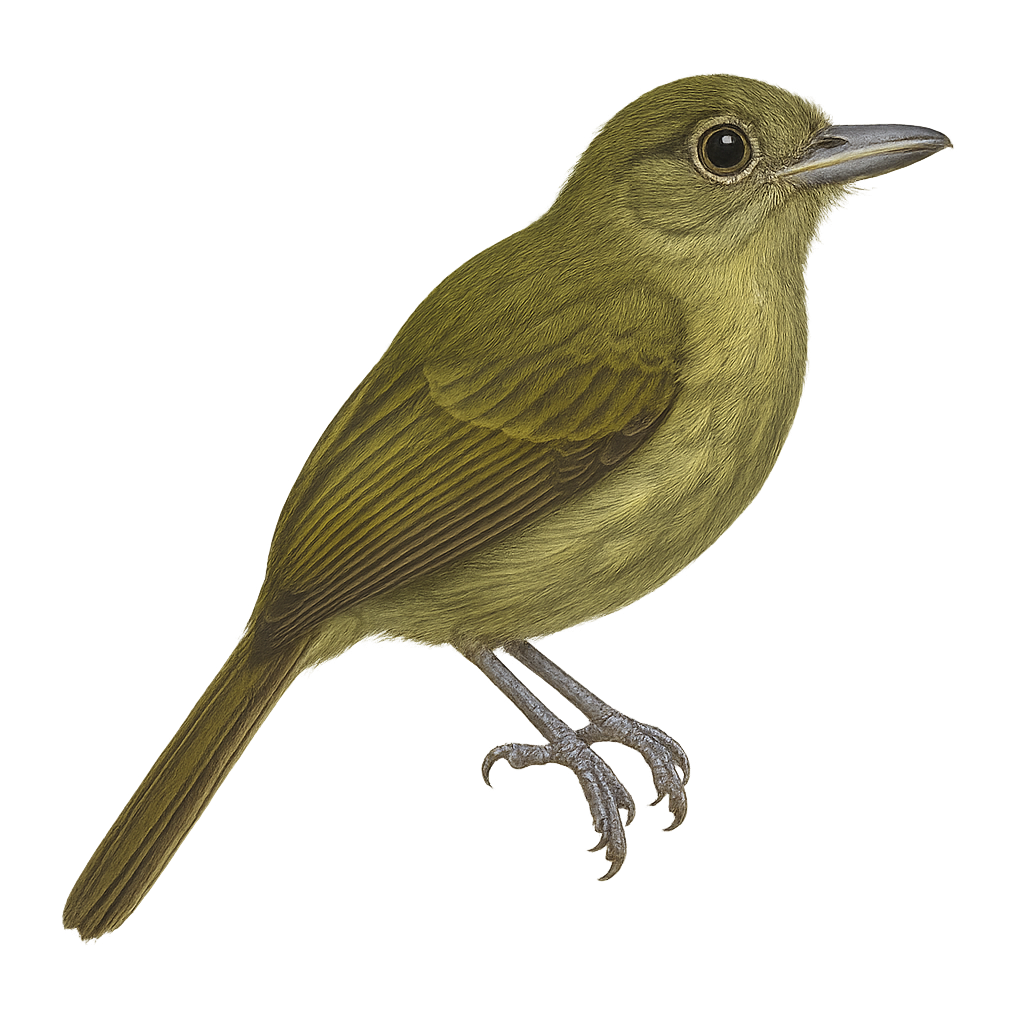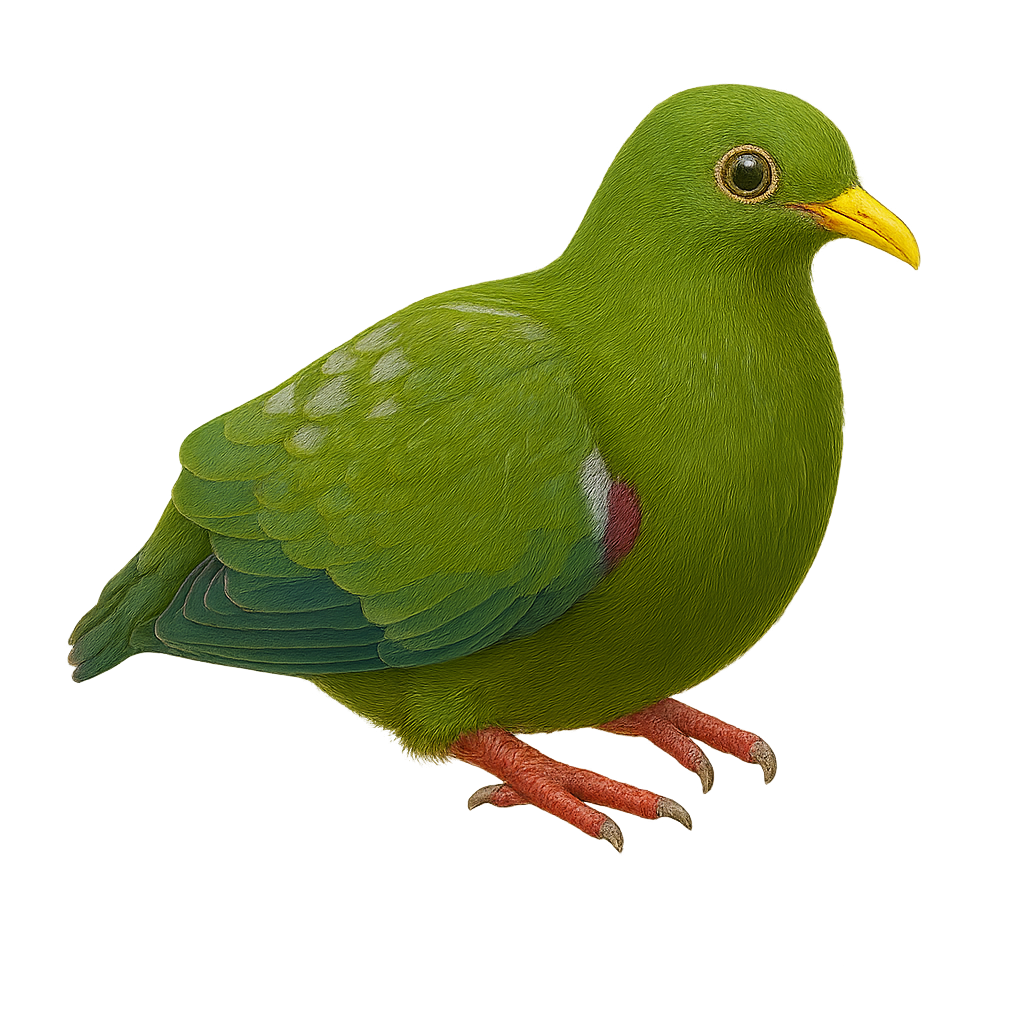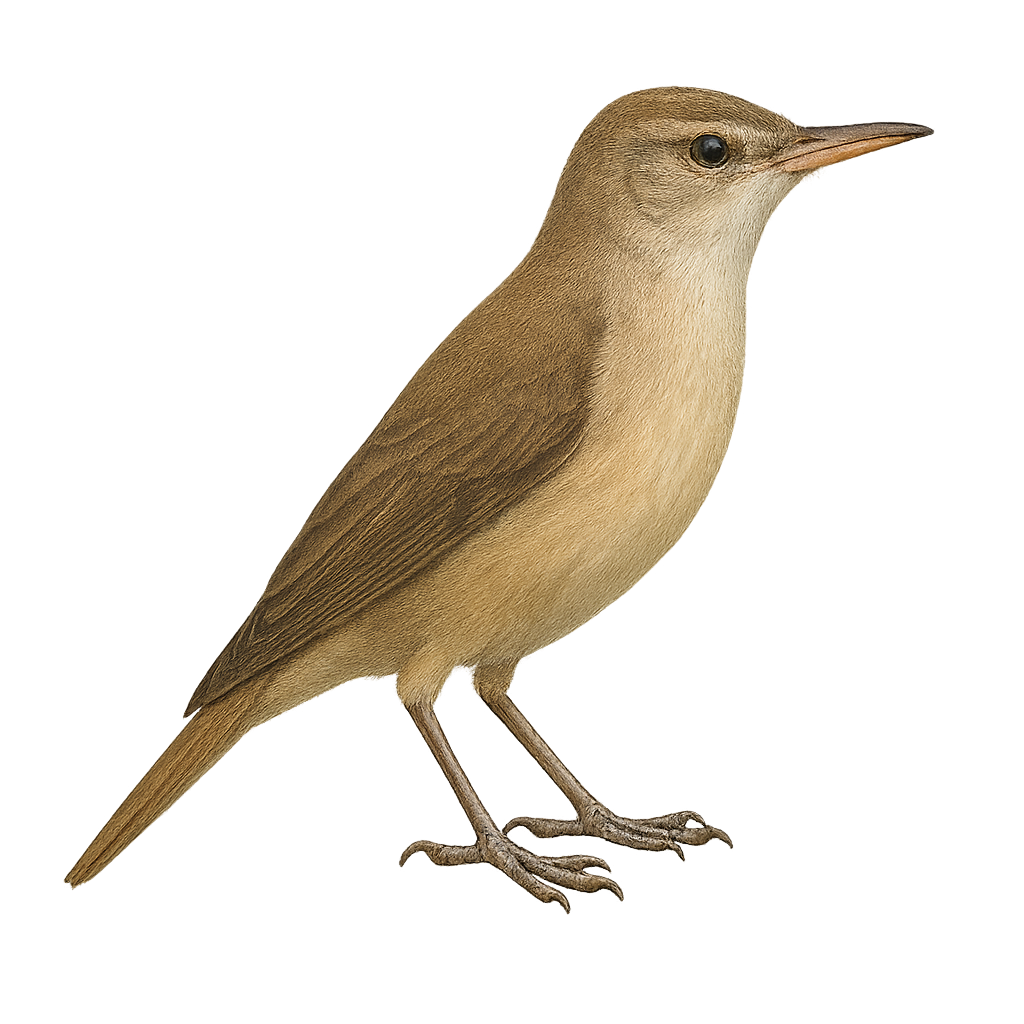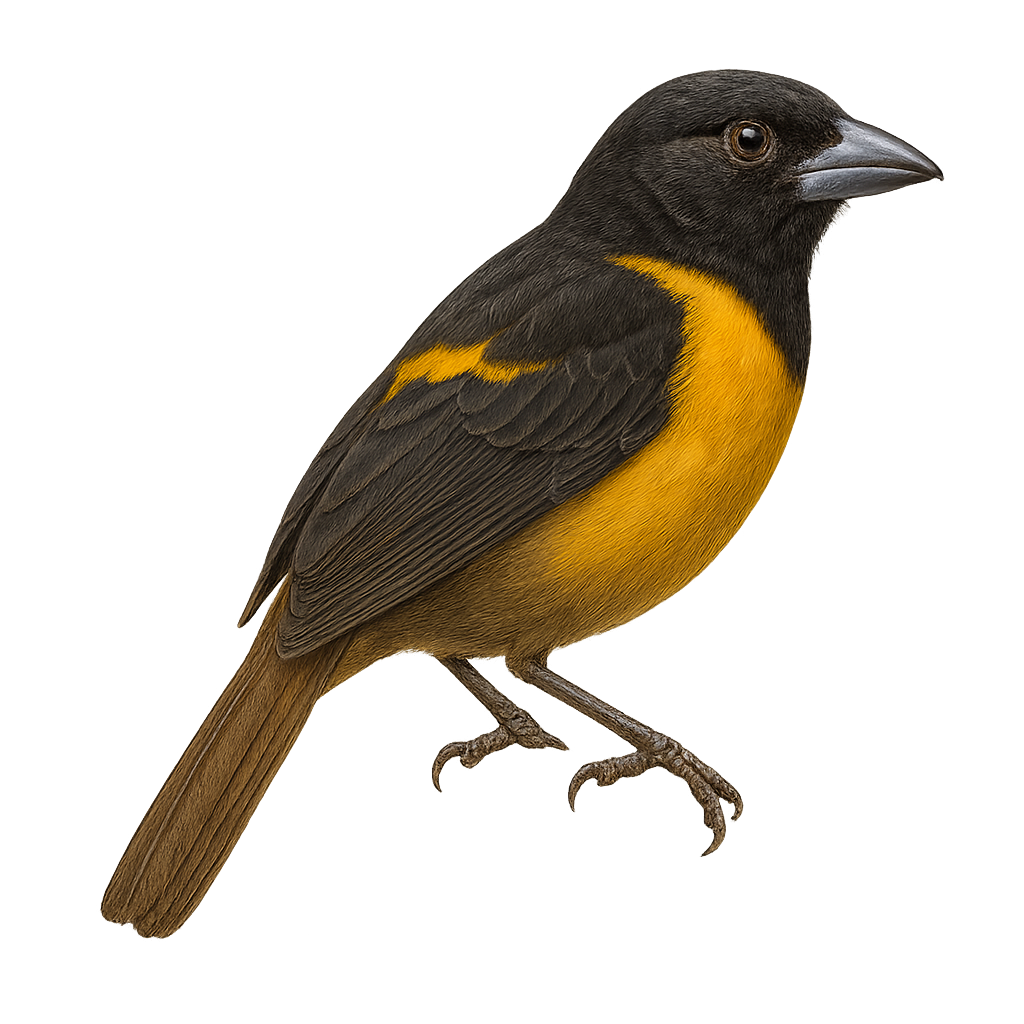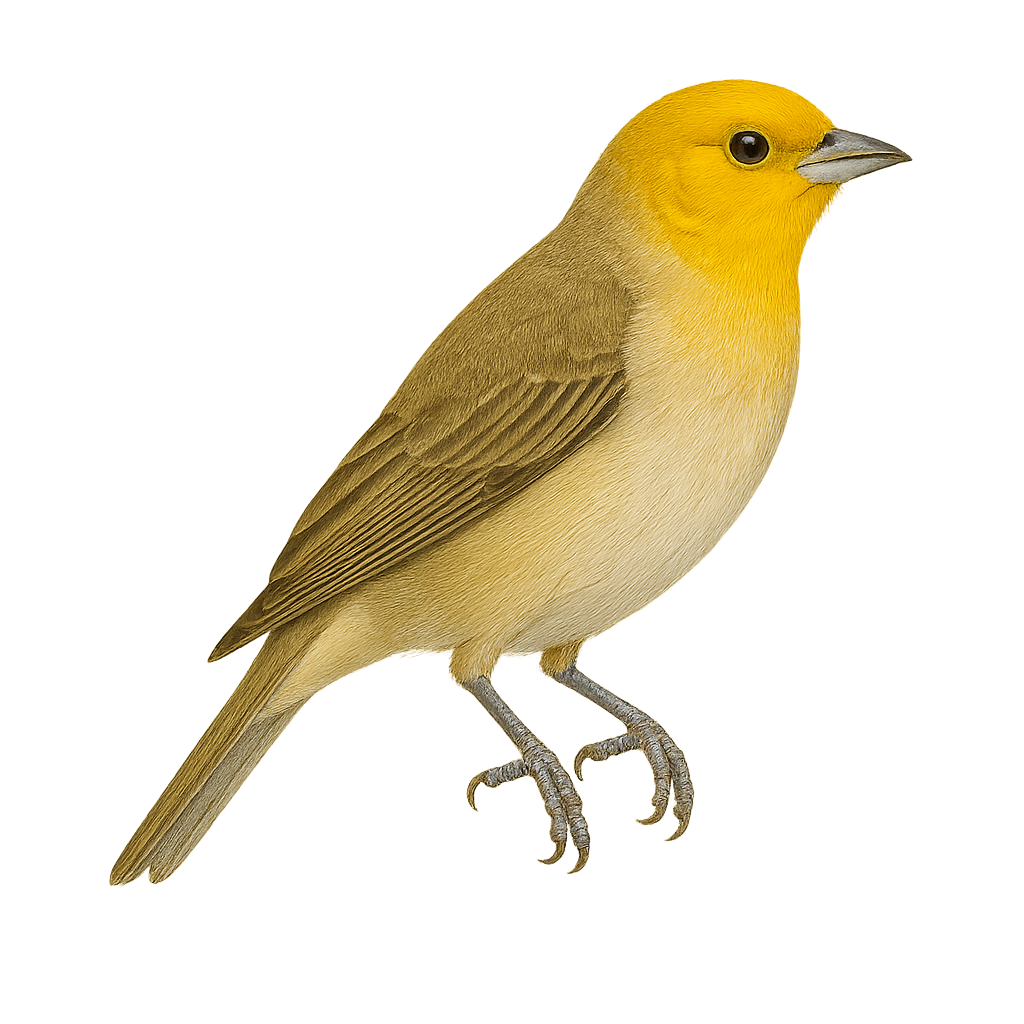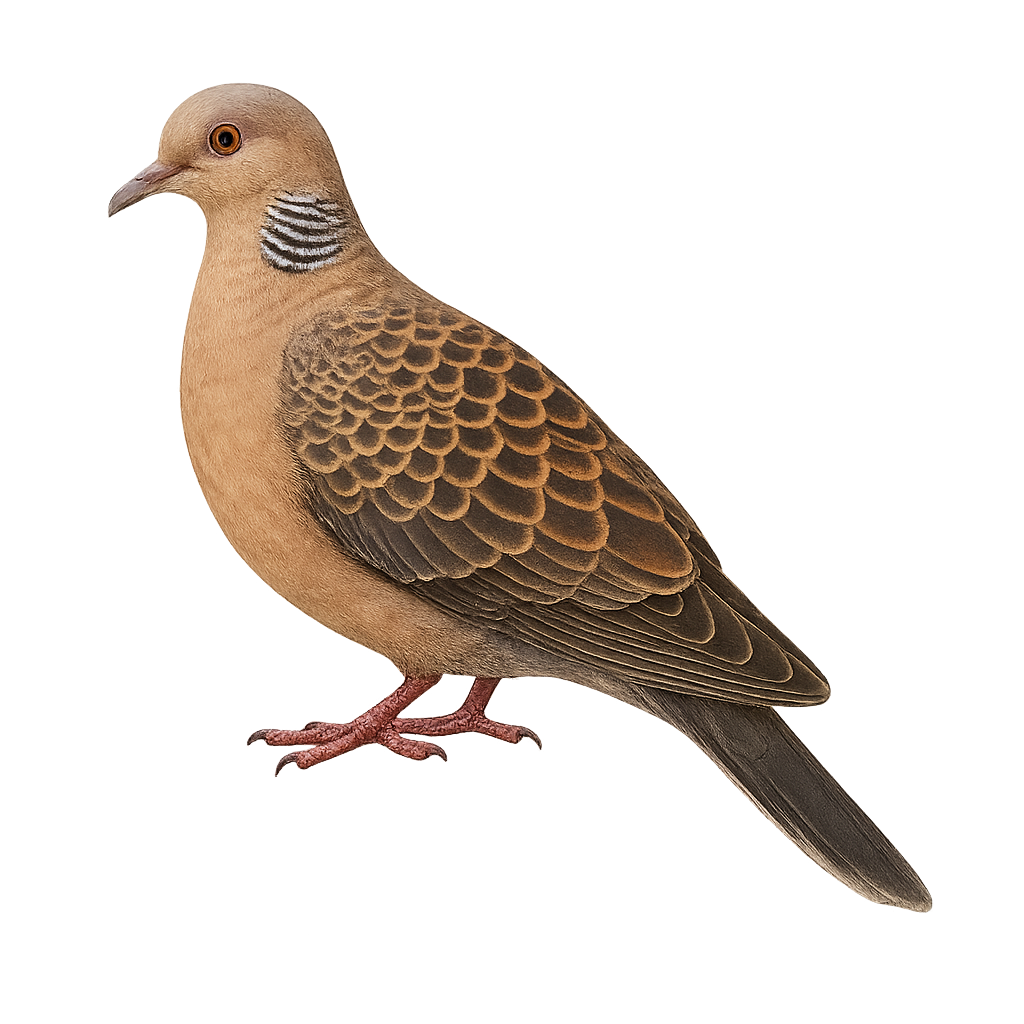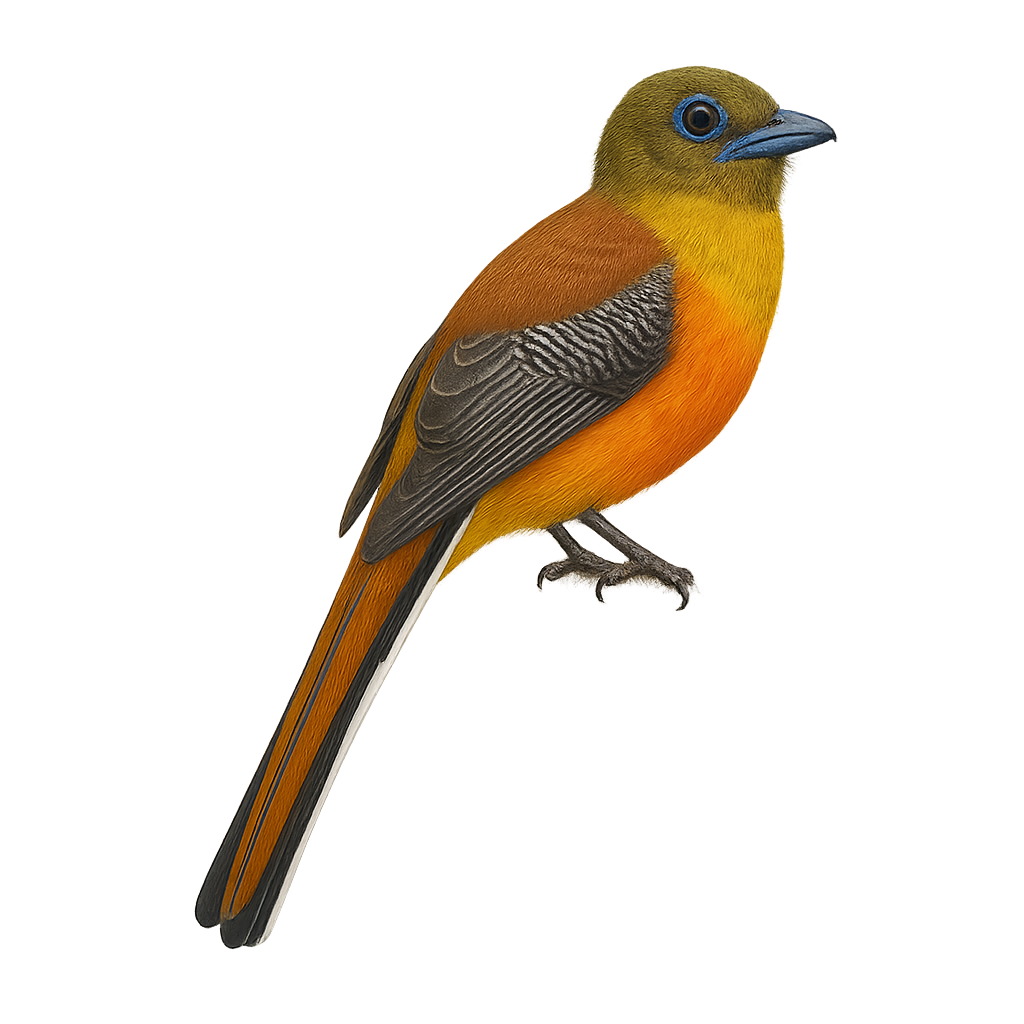The Ornate Hawk-Eagle is a forest raptor from tropical America, measuring between 58 and 67 cm in length. It features a raised black crest, rufous head and flanks, a white throat bordered with black, and a black-and-white barred underside. Juveniles have paler plumage with a white head. An agile predator, it primarily hunts medium to large birds (toucans, parrots, tinamous), arboreal mammals (squirrels, agoutis), and occasionally reptiles. It inhabits primary and secondary humid tropical forests from southern Mexico to Argentina. Deforestation and hunting have led to population declines, classifying it as Near Threatened by the IUCN.
The Orange-cheeked Waxbill is a small, colorful bird native to sub-Saharan Africa. It is easily recognized by its bright orange cheeks and grey-brown plumage. Measuring about 10 to 12 cm in length and weighing between 7 and 10 grams, this bird inhabits savannas, moist grasslands, and cultivated areas, feeding mainly on seeds and insects. It is a social species, often seen foraging on the ground in groups. Its breeding season varies by region, and it is known for building dome-shaped nests in dense bushes.
The Ostrich is the largest living bird on Earth, known for its impressive size and powerful long legs that allow it to run at remarkable speeds, reaching up to 70 km/h. Native to Africa, the Ostrich inhabits savannas and desert regions, where it primarily feeds on plants, seeds, and small insects. Although it cannot fly, its wings and plumage help it maintain balance and protect itself from the sun.
The Ostrich is a social bird, living in groups and known for its interesting defense behaviors. When threatened, it can run at high speeds to flee or crouch to blend into the ground, a method that helps it escape predators.
The Osprey is a remarkable raptor, easily identifiable by its white and brown plumage and keen eyes. This large bird of prey is specialized in fishing, catching fish by diving at high speed from the air. It is mainly found near lakes, rivers, and coastal areas in Europe, Asia, Africa, and the Americas, where it builds large nests on trees or pylons. The Osprey is a solitary bird and an extremely precise hunter, often seen hovering over the water before diving to catch its prey.
Despite its great agility and ability to catch fish, the Osprey is vulnerable to water pollution and habitat destruction. Conservation efforts are underway to protect this iconic species.
The Orange-breasted Waxbill, or Pytilia hypogrammica, is a small, colorful bird belonging to the Estrildidae family. It is primarily found in West Africa, particularly in savannas and open wooded areas. This bird is notable for its vibrant plumage, with a bright orange belly contrasting with gray-green wings and back. Both males and females display similar colors, although males are often more vivid. They primarily feed on seeds but also consume insects, especially during the breeding season. Their song is soft and melodious, often used to attract mates. Although their population is stable, deforestation and capture for the pet trade can pose potential threats.
Small passerine 16–17 cm long with streaked olive-brown plumage and a greenish-grey head. Inhabits cereal fields and margins, feeding mainly on seeds, supplemented by insects during breeding. Pairs nest on the ground, hiding nests among crops or low vegetation, and males sing from low perches to defend territory.
The Oriental Pied Hornbill, Anthracoceros albirostris, is a captivating bird native to the tropical forests of Southeast Asia. Easily identifiable by its large, white beak topped with a distinctive black casque, it measures between 60 and 90 cm. Its striking black and white plumage adds to its allure. These birds live in family groups and are known for their complex social behavior. They primarily feed on fruits but also consume insects and small animals. Their resonant calls often echo through the canopy. The Oriental Pied Hornbill plays a crucial role in seed dispersal, thus contributing to the health of forest ecosystems.
The Oriental Stork, Ciconia boyciana, is a large wading bird belonging to the Ciconiidae family. It is characterized by its striking white plumage contrasted with black wings and a long black bill. Standing about 110 to 115 cm tall, it boasts an impressive wingspan of up to 2 meters. This species is primarily found in East Asia, particularly in China, Russia, and Japan. It inhabits wetlands, marshes, and rice paddies, feeding on fish, amphibians, and insects. The Oriental Stork is an endangered species, mainly due to habitat loss and pollution. Conservation efforts are underway to protect this iconic species.
The Ocellated Turkey, Meleagris ocellata, is a species native to the tropical forests of the Yucatán Peninsula. It is known for its iridescent plumage with metallic hues and eye-like spots on its tail feathers. Males have a bright blue head with red and yellow caruncles. Smaller than the North American Wild Turkey, it is omnivorous, feeding on seeds, fruits, insects, and small animals. The Ocellated Turkey is a social bird, often found in small groups outside the breeding season. Its population is declining due to hunting and habitat loss.
The Olive-backed Woodcreeper is a small bird, about 15 cm in length, characterized by its olive-brown plumage and greyish head and neck. Its slender, slightly curved bill is perfect for probing bark in search of insects. This species is primarily found in the tropical and subtropical forests of Central and South America. It is often seen climbing tree trunks, using its sharp claws for grip. Although discreet, its melodious song is easily recognizable. It plays a crucial role in the ecosystem by controlling insect populations.
The Olive Ibis, scientifically known as Bostrychia olivacea, is a shy and elusive bird found primarily in the tropical rainforests of Central and West Africa. Its distinctive olive-green plumage with metallic sheen makes it a unique sight. Preferring swampy areas and riverbanks, it feeds on insects, small crustaceans, and mollusks. Although often solitary, it can be seen in small groups during the breeding season. The Olive Ibis is a wary bird, making it less studied compared to other ibis species. Its conservation status is concerning due to habitat loss from deforestation.
The Orange-collared Manakin, or Manacus aurantiacus, is a small, vibrant bird found in the tropical rainforests of Central America. Males are particularly striking with their bright orange head and neck contrasting against a black body, while females display more subdued olive-green tones. These birds are famous for their elaborate courtship displays, where males perform intricate dances to attract females. They primarily inhabit dense undergrowth, feeding on fruits and insects. Although their habitat is threatened by deforestation, they remain relatively common within their range.
The Orange-bellied Manakin, or Lepidothrix suavissima, is a small, colorful bird native to the humid tropical forests of South America, particularly in the mountainous regions of Venezuela. This passerine is known for its vibrant plumage, with males displaying bright colors to attract females during the breeding season. Females, on the other hand, have more subdued, often olive-green plumage, allowing them to blend into the dense foliage. The Orange-bellied Manakin is a diurnal bird, active mainly during the day, and feeds primarily on fruits and insects. It is often seen in small groups, although it can also be solitary. Its courtship dance is a fascinating spectacle, with the male performing complex movements to woo his mate.
The Ornate Melidectes, or Melidectes torquatus, is a bird endemic to New Guinea. It is characterized by its olive-brown plumage with a distinctive white collar around its neck. This bird measures about 20 to 25 cm in length and has a slightly curved beak, adapted to its diet mainly consisting of nectar and insects. It primarily inhabits tropical rainforests and mountainous areas, playing a crucial role in plant pollination. Although generally suspicious, it can become accustomed to human presence in protected areas. Its population is stable, but deforestation poses a potential threat to its natural habitat.
The Olive-sided Flycatcher is a medium-sized migratory bird belonging to the Tyrannidae family. It is easily recognizable by its slender silhouette and distinctive olive sides. Its plumage is primarily gray-brown with a contrasting white chest. This bird is often seen perched high, scanning its surroundings for flying insects, its main food source. It is known for its distinctive song, often described as "quick, three beers!" in English. The Olive-sided Flycatcher primarily nests in the coniferous forests of northern America but migrates to Central and South America for the winter. Its population is declining due to habitat loss and climate change.
The Olive-backed Euphonia, or Euphonia gouldi, is a small, colorful bird from the Fringillidae family, primarily found in the humid tropical forests of Central America. It is distinguished by its vibrant plumage, with an olive-green back and bright yellow chest. Males have a metallic blue cap, while females display duller tones. This bird is often seen in pairs or small groups, feeding mainly on fruits and berries. Its melodious and varied song is often heard at dawn and dusk. Although its habitat is threatened by deforestation, the species is currently classified as of least concern by the IUCN.
The Orinoco Goose, Oressochen jubatus, is a waterbird species typical of the wetlands and riverbanks of South America, especially in Venezuela, Colombia, and northern Brazil. It stands out with its warm brown plumage, pale head with a subtle crest, and striking red legs. A non-migratory resident, it breeds near sandy shores and flooded areas. Its diet is mainly vegetarian, feeding on seeds, shoots, and aquatic plants. Fairly wary, it usually takes flight when humans approach.
The Orange-bellied Parrot is a small parrot endemic to Australia, known for its vibrant plumage and distinct orange belly. Measuring about 20 cm in length, it features a bright green back, orange belly, and blue markings on the wings and head. This migratory species breeds in southwest Tasmania and migrates to the southeast coast of mainland Australia in winter. It primarily feeds on seeds of grasses and coastal plants. Unfortunately, it is critically endangered, with fewer than 50 wild individuals remaining. Conservation efforts include captive breeding programs and protection of its natural habitat.
The Olivaceous Piculet is a small bird from the Picidae family, identifiable by its olive-green plumage and diminutive size, measuring about 10 cm in length. It primarily inhabits the tropical rainforests of South America, particularly in Colombia, Venezuela, and Ecuador. Its short, sturdy beak is adapted for pecking tree bark in search of insects. The male is distinguished by a small red patch on its head, which is absent in females. This piculet is often seen in small groups or pairs, actively moving through foliage in search of food. Although relatively common in its habitat, it remains discreet and hard to spot due to its coloration blending into the dense foliage.
The Olive-backed Pipit, or Anthus hodgsoni, is a small passerine bird in the Motacillidae family. It is primarily found in wooded regions of Asia, including Siberia, China, and the Himalayas. This pipit is characterized by its olive-brown back and dark streaks on its breast, which help it blend into its forested habitat. A migratory bird, it winters in Southeast Asia. Its song is a key identification feature, often described as a melodious whistle. It primarily feeds on insects and small invertebrates found on the ground. The Olive-backed Pipit is a discreet bird, often difficult to spot due to its elusive behavior and cryptic plumage.
The Piprites chloris, or Olive-green Tyrannulet, is a small, colorful bird found in the tropical forests of South America. It is recognizable by its olive-green plumage and slightly lighter head. This passerine is known for its discreet behavior and ability to blend into dense foliage. It primarily feeds on insects and fruits, which it captures with agility thanks to its quick and precise movements. The Olive-green Tyrannulet is often observed in small groups, although it can also be solitary. Its breeding season varies by region but is generally active during the rainy season when food is plentiful.
The Olivaceous Flatbill, or Rhynchocyclus olivaceus, is a small bird belonging to the Tyrannidae family. It is primarily found in the humid forests of Central and South America, where it is recognized by its olive-green plumage and flattened bill. This discreet bird is often seen alone or in pairs, feeding on insects caught in flight or on leaves. Its song is a soft whistle, often heard at dawn and dusk. Although its habitat is threatened by deforestation, it remains relatively common in protected areas. Its ability to blend into the foliage makes it difficult to spot, but its presence is often revealed by its distinctive song.
The Orange-bellied Fruit Dove, or Ptilinopus iozonus, is a colorful and fascinating bird primarily found in the rainforests of New Guinea and surrounding islands. This medium-sized pigeon, measuring about 24 cm in length, is easily recognizable by its vibrant plumage. Its bright orange belly contrasts with the vivid green of its wings and back, while its head displays shades of gray and violet. It primarily feeds on fruits, playing a crucial role in seed dispersal. Although often seen alone or in small groups, its discreet behavior sometimes makes it difficult to spot. Its ability to blend into dense foliage is impressive, making it a challenge for birdwatchers and photographers.
The Oriental Reed Warbler, Acrocephalus orientalis, is a medium-sized bird belonging to the Acrocephalidae family. It is primarily found in Asia, particularly in eastern Russia, China, and Japan. This migratory bird is known for its long journeys to Southeast Asia during the winter. Its plumage is generally olive-brown on the top and lighter underneath, allowing it to blend into the reeds and marshes it frequents. The Oriental Reed Warbler feeds mainly on insects and small invertebrates, which it captures in dense foliage. Its song is melodious and varied, often heard in spring and summer.
The Oriental Magpie-Robin, or Copsychus saularis, is a medium-sized songbird known for its distinctive black and white plumage. The male features glossy black feathers on its back and head, while the belly and wings are white. The female, however, has more grayish tones. This bird is renowned for its melodious and varied song, often heard at dawn and dusk. Native to South and Southeast Asia, the Oriental Magpie-Robin inhabits various environments, from tropical forests to urban gardens. It primarily feeds on insects but can also consume fruits. Although generally solitary, it may be seen in small groups during the breeding season.
The Orange-backed Tanager, Lanio aurantius, is a colorful and captivating bird native to the tropical forests of Central America. It is easily recognizable by its bright orange back contrasting with the rest of its black body. This bird measures about 18 cm in length and primarily feeds on fruits, insects, and small invertebrates. It usually lives in small groups or pairs, often in the company of other tanager species. The Orange-backed Tanager is an active and vocal bird, emitting a variety of songs and calls to communicate with its peers. Although its habitat is threatened by deforestation, it remains relatively common in some areas.
The Orange-headed Tanager is a small, colorful bird found mainly in South America. It is recognizable by its bright orange head contrasting with its gray and brown body. This passerine frequents humid tropical forests, forest edges, and sometimes more open wooded areas. Often seen in small groups or pairs, it feeds primarily on insects and fruits. Although its habitat is relatively stable, it is sometimes threatened by deforestation. The Orange-headed Tanager is an active and agile bird, often seen hopping from branch to branch in search of food. Its breeding period varies by region, but it is generally not very shy, making it accessible for observation.
The Olive Sparrow, Arremonops rufivirgatus, is a small passerine bird belonging to the Passerellidae family. It is primarily found in wooded and shrubby areas of southern Texas and northeastern Mexico. Its plumage is mainly olive with shades of brown, allowing it to blend seamlessly into its natural surroundings. The Olive Sparrow is a discreet bird, often heard before being seen, thanks to its distinctive and repetitive song. It primarily feeds on seeds and insects found by foraging on the ground. Although relatively common within its range, it remains difficult to spot due to its discreet behavior and dense habitat.
The Oriental Turtle Dove, or Streptopelia orientalis, is a medium-sized bird, measuring about 30 to 33 cm in length. It is recognizable by its light brown plumage with pinkish hues on the chest and distinctive black bands on the neck. Its wings have scaly patterns, and its tail is long and slightly rounded. This bird is often seen in forests, agricultural areas, and urban parks. The Oriental Turtle Dove is primarily granivorous, feeding on seeds and grains, but it can also consume insects. It is known for its soft and melodious song, often heard at sunrise and sunset.
The Orange-breasted Trogon, or Harpactes oreskios, is a captivating bird found in the tropical forests of Southeast Asia. It is known for its vibrant plumage, featuring a bright orange breast and wings with shades of brown and black. This elusive bird prefers dense forests where it feeds mainly on insects and small fruits. Its melodious call often echoes through the canopy, although the bird itself is hard to spot due to its discreet behavior. The Orange-breasted Trogon nests in tree cavities, where the female typically lays two to three eggs. Although its habitat is threatened by deforestation, it remains relatively common in some areas.


